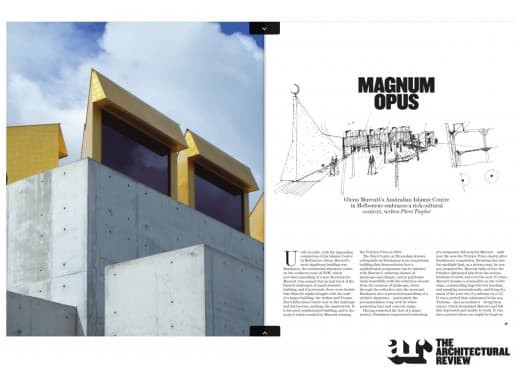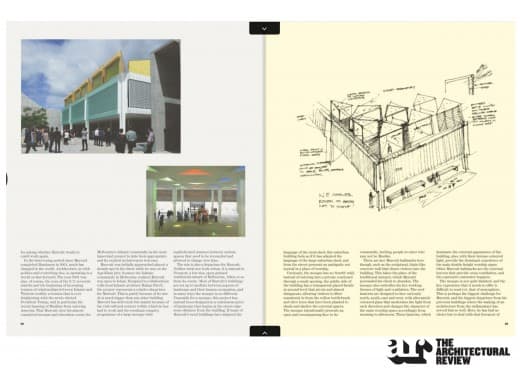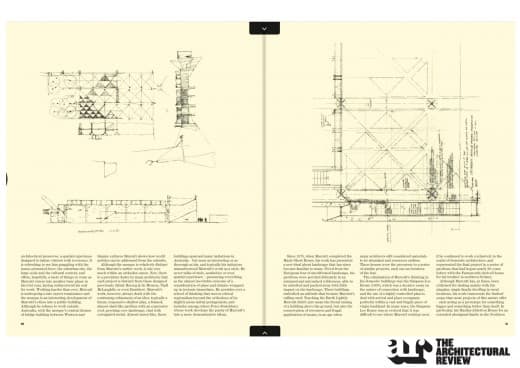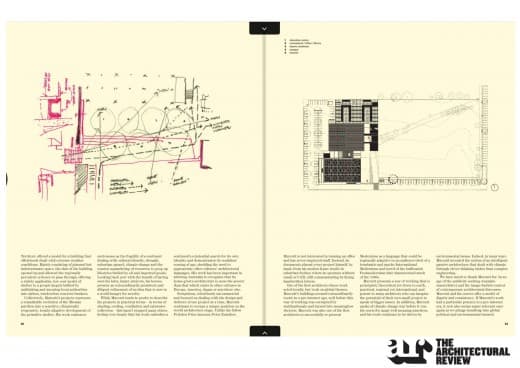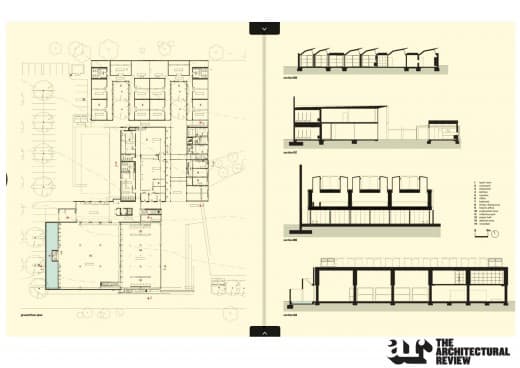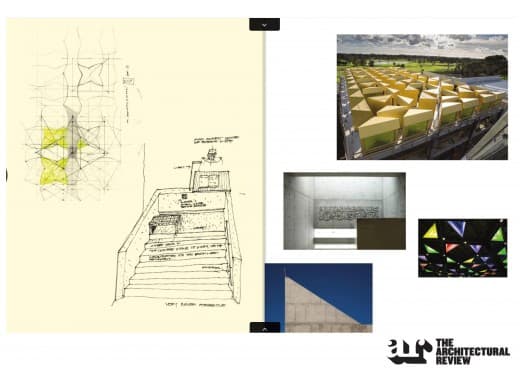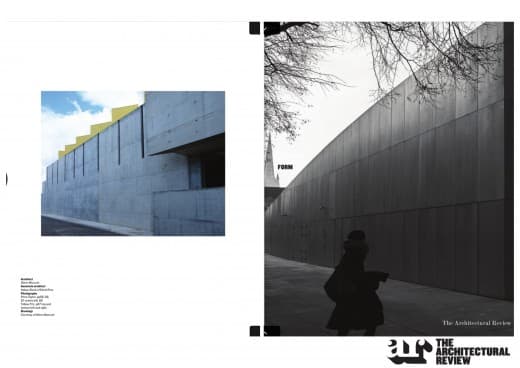Piers Taylor’s Review of Glenn Murcutt’s Mosque – the Australian Islamic Centre – is in April’s edition of the Architectural Review
Glenn Murcutt & Newport Mosque
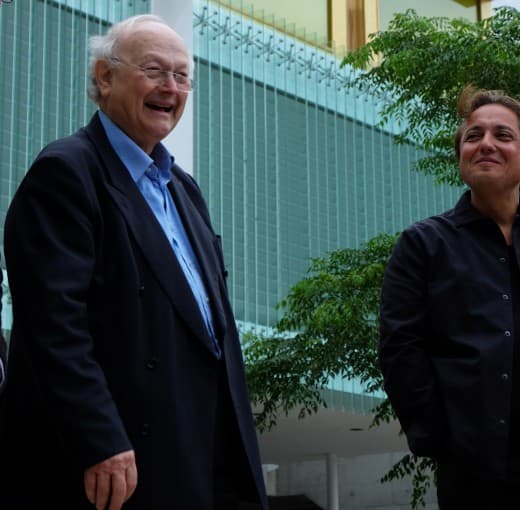
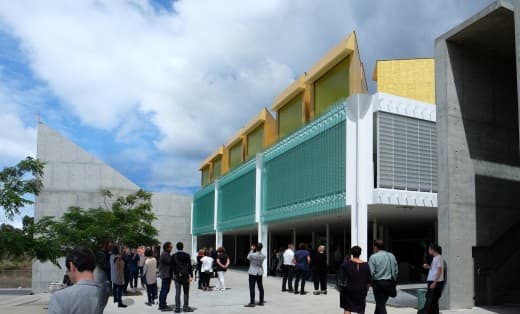 Piers Taylor’s Article for the Architectural Review on Glenn Murcutt’s work, and his recently completed Melbourne Islamic Centre
Piers Taylor’s Article for the Architectural Review on Glenn Murcutt’s work, and his recently completed Melbourne Islamic Centre
Glenn Murcutt occupies a unique and singular position on the world architecture stage. He is scrupulous, relentlessly un-commercial and focused on dealing with the design and delivery of one project at a time. Unlike his fellow Pritzker Prize laureate Peter Zumthor, Murcutt is not interested in running an office and has never employed staff. Instead, he documents almost every project himself, by hand, from his modest home studio in suburban Sydney where he operates without email or CAD, still communicating by faxing hand written letters. Although Murcutt doesn’t philosophise much around his modus operandi and his modest yet highly influential built work, plenty of others do.
Murcutt tends to prefer to describe his projects in practical terms – in terms of shading, cooling, ventilation and rainwater collection, but that hasn’t stopped many others feeling very deeply that his work embodies a continent’s existential search for its own identity and demonstrates its confident coming of age, shedding the need to appropriate other cultures’ architectural languages. His work has been important in allowing Australia to recognise that its home-grown architecture is none the poorer than that which exists in other cultures in Europe, America, Japan or anywhere else.
We have a good deal to thank Murcutt for. In an age of the publicity seeking wannabe superstar architect and the image fuelled context of contemporary architectural discourse, Murcutt and his oeuvre offer a model of dignity and consistency. He shot to world fame in the early 1990s after winning the Alvar Aalto Medal for a body of work designed over the previous 20 years or so which collectively represented a remarkable evolution of the Miesian pavilion into a sensitive, climatically responsive, locally adaptive development of the primitive shelter. His work embraced such issues as the fragility of a continent dealing with cultural identity, drought, suburban sprawl, climate change and the wanton squandering of resources to prop up lifestyles fuelled by oil and imported goods.
Murcutt’s work had a particular potency in a pre-internet era, but also seems super relevant once again as we plunge headlong into global political and environmental turmoil. Murcutt was one of the first architects whose work acted locally, but took on global themes and this seemed extraordinarily exotic in a pre-internet age, well before this way of working was corrupted by multinationals and turned into meaningless rhetoric. Murcutt was one the first architects to successfully re-present modernism as a language that could be regionally adaptive to an audience tired of bombastic and macho international modernism and bored of buffoonish post modernism that characterized much of the 1980s. Here was a way of working that was principled, theoretical yet down to earth, practical, regional yet international and potent to many architects who could imagine the potential of their own small project to speak of bigger issues. Murcutt also spoke of climate change way before it was the norm for many well-meaning practices. Indeed, in many ways Murcutt invented the notion of an intelligent, passive architecture that dealt with climate through clever thinking rather than complex engineering.
Although Murcutt has been criticised for dealing mainly with the singular, single-family dwelling in rural locations, his work transcends the limited scope that most projects of this nature offer – each acting as a prototype for something bigger and something better than itself. In particular, his Marika Alderton house for an extended aboriginal family in the Northern Territories offered a model for a building that effortlessly dealt with extreme weather conditions. Mainly consisting of planned but indeterminate space, the skin of the building opened up and allowed the regionally prevalent cyclones to pass through, offering a widely applicable, low cost model of shelter to a people largely bullied by unthinking and uncaring local authorities into airless, windowless concrete bunkers. This house was an evolution of a typology that Murcutt had been developing since the Marie Short House in 1975 – two permeable narrow plan pavilions designed around an existing stack of timber and the limited resources of his client. Critically, also, this building embodied an attitude that has become Murcutt’s calling card: Touching the Earth Lightly. Murcutt, of course didn’t just mean the literal raising of a building above the ground, but also the conservation of resources and frugal application of means, in an age when many architects still consider materials to be abundant and resources endless.
The Marie Short house and the Ball Eastway House that followed also embodied a new ideal about landscape that has become familiar to many over the years – freed from the European fear of uncultivated landscape, these pavilions were perched delicately in an untamed and untouched wilderness, able to be unbolted and packed away with little impact on the landscape. These houses were the precursor to a series of similar projects, each one an iteration of the last, as Murcutt painstakingly and patiently refined the themes that he had developed.
Now, there is a prevalent desire by many architects that each project is distinct from those designed previously (think Herzog & de Neuron, Niall McLaughlin or even Zumthor). Murcutt’s work, however, dealt with continuing refinement of an idea: a linear, responsive shallow plan, a framed, almost shed-like pavilion with an expressive roof, perching over landscape, clad with corrugated metal. Almost insect like, these buildings spawned many imitations in Australia – but none as interesting or as thorough as Murcutt’s, and typically his imitators misunderstood Murcutt’s work as a style. Murcutt never talks of style, aesthetics or even spatial experience – presenting everything as the almost inevitable outcome of a consideration of place and climate wrapped up in tectonic immediacy. Murcutt presides over a school of thinking that moves critical regionalism beyond the orthodoxy of its slightly pious initial protagonists, and includes among others, Peter Stutchbury whose work develops the purity of Murcutt’s into a more demonstrative idiom.
Over 15 years or so from the Ball-Eastway house, Murcutt set out the culmination of his thinking in his domestic buildings with the Simpson Lee house – a refined essay on the nature of connection with landscape, arrival, orientation, shading, water collection and the nature of occupation within a semi wilderness. In many ways, it was so perfectly evolved that it was difficult to see where Murcutt could go next if he continued to work exclusively in the realm of domestic architecture, and represented the final project in a series of pavilions that had begun nearly 30 years before with the Farnsworth derived house for his brother in northern Sydney.
With his next significant building, Murcutt set out a new direction in one of his few non-domestic buildings – a residential education centre on the southern coast of NSW on the site of Arthur Boyd Foundation at Bundanon. One sensed that Murcutt was tiring of limited challenges of the small domestic building, and if previously there were doubts that Murcutt might struggle with the scale of a larger building, the Arthur Boyd Centre rose to the challenge and has become, perhaps, his masterwork. It is his most sophisticated building, and is the project which resulted in Murcutt winning the Pritzker Prize in 2001 – certainly without this project, it is unlikely to think that he would have won the accolade.
The Arthur Boyd Centre (known colloquially as Bundanon) is an exceptional building in that it demonstrates how a sophisticated programme can be married with Murcutt’s enduring themes of landscape and climate, and in particular deals beautifully with the reduction of scale from the vastness of landscape, down through the collective, into the personal. Bundanon also represented something of stylistic departure – particularly in the accommodation wing with its white projecting bays and concrete spine. That the project was a collaboration with his wife Wendy Lewin is interesting: for a singular practitioner, Murcutt has often been a generous collaborator, and Lewin brings much to this project.
Bundanon is perfectly set up to deal with the expectations around arrival. In his description of his buildings Murcutt avoids the romantic, and in many ways Bundanon is almost classical in the manner it deals with the orientation of an individual in landscape. Like his smaller buildings, Bundanon is environmentally optimised, but It develops the language set up in his domestic buildings in how it with deals with the communal, and mitigates successfully between the public and the private to a degree not typical in many similar buildings. Having scratched the itch of a larger project, in many ways, Bundanon represented something of a temporary full stop for Murcutt. He won the Pritzker Prize shortly after its completion, and thrust Murcutt onto a world stage that, as a private and almost reclusive man, he was possibly not prepared for. He talks about how the Pritzker distracted him from the serious business of work, and over the next ten years, Murcutt became a commodity on the world stage, commanding huge fees for teaching and speaking internationally, and lived for much of the year out of a suitcase on a 747. It was a period that culminated in his son, Nicholas – also an architect – dying from cancer, which devastated Murcutt and left him depressed and unable to work. It was also a period where one might be forgiven for asking whether Murcutt would or could work again.
In the intervening period since Murcutt completed Bundanon in 2001, much has changed in the world. Architecture, as with politics and everything else is operating in a world on fast forward. 2001 was also, of course, the year of the 9/11 terrorist attacks and the beginning of increasing tensioning of relationships between Islamic and western worlds: a tension that is ever heightening with the newly elected President Trump, and in particular his recent banning of Muslims from entering America. That Murcutt cites his almost completed new Mosque for Melbourne’s Islamic community as his most important project to date feels appropriate, and its explicit inclusiveness welcome.
Murcutt was approached almost a decade ago by his client while he was on the Aga Kahn jury because the Islamic Community in Melbourne realised Murcutt was open to Islam. Designed in collaboration with local Islamic architect Hakan Elevli, the Mosque represents a relative departure for Murcutt in many ways. This is partly because of its size (it is much bigger than any other building Murcutt has delivered) but mainly because of the rich cultural context within which he has had to work, and the resultant complex programme of a large mosque with sophisticated nuances between various spaces that need to be reconciled and allowed to change over time.
The site is also a departure for Murcutt. Neither rural nor truly urban, it is instead in Newport, a low rise, open grained residential suburb of Melbourne, 10 kilometres or so from its centre. Most of Murcutt’s buildings are set up to mediate between aspects of landscape and their human occupation, and in many ways the mosque is no different. Unusually for a Mosque, this project has instead been designed as a continuous piece of landscape that begins at the street edge some distance from the building. If many of Murcutt’s rural buildings have adapted the language of the rural shed, this suburban building feels as if it has adapted the language of the large suburban shed, and from the street presents an ambiguity not typical in a place of worship.
Curiously, the Mosque has no ‘fourth’ wall; instead of entering into a private courtyard through a small opening in a large wall, the public side of the building has a transparent, glazed façade at ground level that pivots and almost disappears, allowing visitors to filter seamlessly in from the Willow Bottlebrush and Olive trees that have been planted to shade the external spaces. The Mosque intentionally presents an open and encompassing face to its community, inviting people to enter who may not be Muslim.
There are key Murcutt hallmarks here though: the sculptural, blade like concrete wall that deals with arrival and acts to draw visitors into the building. This takes the place of the traditional minaret, which Murcutt persuaded his client to abandon. The Mosque also embodies his working themes of light and ventilation. The roof lanterns are designed to face variously north, south, east and west, with alternatively coloured glass that moderates the light from each direction and changes the character of the main worship space accordingly from morning to afternoon. These lanterns, which dominate the external appearance of the building, also, with their intense coloured light, provide the dominant experience of the main double height worship space. The other Murcutt hallmarks are the external louvres providing cross ventilation, and also the expressive rainwater hoppers.
The Mosque is not quite finished, and the key experience that it needs to offer is difficult to read yet: that of atmosphere. This is perhaps the biggest challenge for Murcutt, and the biggest departure from his previous buildings where the making of an architecture from the rudimentary has served Murcutt so well. Here, he has had no choice but to deal with that foremost of architectural preserves: a spatial experience designed to imbue visitors with reverence. It is refreshing to see him grappling with the issues presented in this project: the suburban site, the large scale and the cultural context, and offers, hopefully, a taste of things to come as Murcutt enters into another busy phase in his 80th year, having rediscovered his customary zeal for work. Currently working harder ever, Murcutt is undergoing something of a late career renaissance. Although he refuses to work outside Australia, with the mosque’s central themes of bridge building between western and Islamic cultures, Murcutt shows how world politics can be addressed from the suburbs.
© Piers Taylor 2017
Categories
- 100k house
- Articles
- brexit
- Caretaker's House
- Christchurch
- current
- East Quay Watchet
- film
- ghost barn
- Glenn Murcutt
- Heroes
- Hooke Park
- House in an Olive Grove
- Invisible Studio
- longdrop
- Mess Building
- Moonshine
- On the Road Again
- passihvaus
- piers taylor
- piers,taylor
- press
- Projects
- Riverpoint
- Self Build
- Stillpoint
- Studio Build
- Studio in the Woods
- talks
- Trailer
- truss barn
- Uncategorized
- Vernacular Buildings
- watchet
- Westonbirt
Tags
- caretaker's house
- design and make
- Design Build Workshop
- Design Make
- east quay
- east quay watchet
- Glenn Murcutt
- green timber architecture
- Hooke Park
- Hooke Park Big Shed
- Invisible Studio
- Low Impact House
- moonshine
- Onion Collective
- piers taylor
- Piers Taylor Architect
- piers taylor invisible studio
- self build
- self build architect
- Starfall Farm
- Stillpoint Bath
- studio in the woods
- Sustainable Architecture
- The house that £100k built
- timber architecture
- Timber House
- timber workshop
- visible studio
- westonbirt architecture
- westonbirt tree management centre
